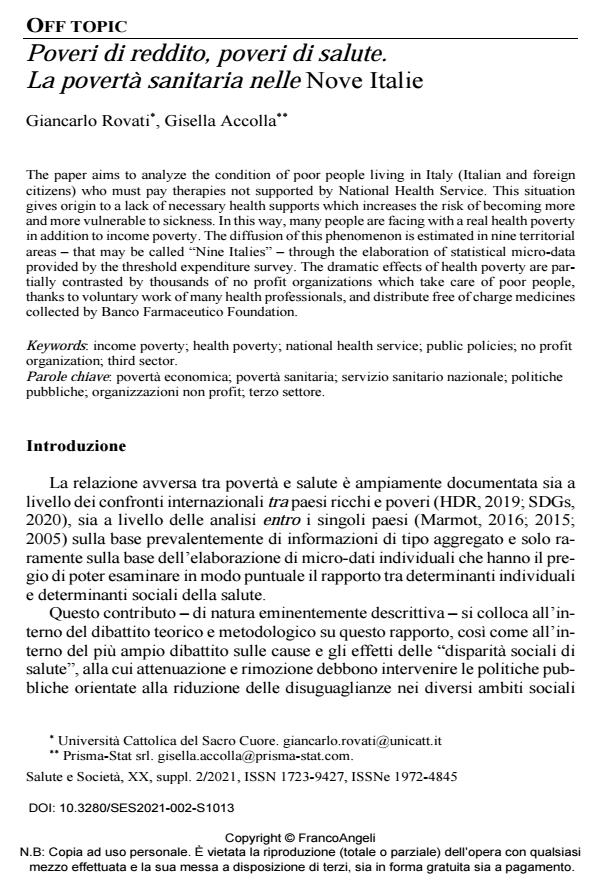Poveri di reddito, poveri di salute. La povertà sanitaria nelle Nove Italie
Journal title SALUTE E SOCIETÀ
Author/s Giancarlo Rovati, Gisella Accolla
Publishing Year 2021 Issue 2021/suppl. 2 Language Italian
Pages 20 P. 199-218 File size 316 KB
DOI 10.3280/SES2021-002-S1013
DOI is like a bar code for intellectual property: to have more infomation
click here
Below, you can see the article first page
If you want to buy this article in PDF format, you can do it, following the instructions to buy download credits

FrancoAngeli is member of Publishers International Linking Association, Inc (PILA), a not-for-profit association which run the CrossRef service enabling links to and from online scholarly content.
The paper aims to analyze the condition of poor people living in Italy (Italian and foreign citizens) who must pay therapies not supported by National Health Service. This situation gives origin to a lack of necessary health supports which increases the risk of becoming more and more vulnerable to sickness. In this way, many people are facing with a real health poverty in addition to income poverty. The diffusion of this phenomenon is estimated in nine territorial areas that may be called "Nine Italies" - through the elaboration of statistical micro-data provided by the threshold expenditure survey. The dramatic effects of health poverty are partially contrasted by thousands of no profit organizations which take care of poor people, thanks to voluntary work of many health professionals, and distribute free of charge medicines collected by Banco Farmaceutico Foundation.
Keywords: income poverty; health poverty; national health service; public policies; no profit organization; third sector.
- Age.na.s (2020). Programma nazionale Esiti 2020. Roma: Ministero della salute.
- AIFA (2020). Rapporto Osmed 2019. Roma. Cersosimo G. (2012). Salute e disuguaglianze. Percorsi analitici. Sociologia e Ricerca sociale, 97: 50-75. DOI: 10.3280/SR2012-09700
- Corrao G. (2020). Modelling effectiveness, cost-effectiveness and promoting health care value in the real world. The Motive project. Progetto PRIN 2017 (grant n. H45J17000500006).
- Costa G., a cura di (2010). Povertà e salute. Roma: Quaderni Cies n. 1. HDR 2019 (Human Development Report). Beyond income, beyond averages, beyond today: Inequalities in human development in the 21st century, (see chapter 7, Policies for reducing inequalities in human development in the 21st century: We have a choice. New York: United Nations Development Programme (UNDP).
- ISTAT (2009). La misura della povertà assoluta. Roma: Metodi e norme n. 39.
- ISTAT (2020). Le statistiche ISTAT sulla povertà. Anno 2019. Statistiche Report, 16 giugno. Roma: ISTAT.
- ISTAT (2021). Stime preliminari povertà assoluta e delle spese per consumi. Statistiche Today, 4 marzo. Roma: ISTAT.
- Marmot M. (2005). Social determinants of health inequalities. The Lancet, 365: 1099-1104. DOI: 10.1016/S0140-6736(05)74234-
- Marmot M. (2015). The health gap. London: Bloomsbury Publishing.
- Marmot M. (2016). La salute disuguale. La sfida di un mondo ingiusto. Roma: Il Pensiero Scientifico Editore. Milano: FrancoAngeli.
- OECD (2020). Health at a Glance. Europe 2020. Paris: OECD Publishing.
- Sarti S., Vitalini A. (2016). La salute degli italiani prima e dopo la crisi economica (2005- 2013): alcune evidenze empiriche sulle categorie sociali a maggior rischio di impatto. Quaderni di Sociologia, 72: 31-55.
- SDGs (The Sustainable Development Goals Report 2020). Goal 3: Ensure healthy lives and promote well-being for all at all ages. New York: United Nations, Terraneo M. (2018). La Salute negata. Le sfide dell'equità in prospettiva sociologica. Milano: FrancoAngeli.
Giancarlo Rovati, Gisella Accolla, Poveri di reddito, poveri di salute. La povertà sanitaria nelle Nove Italie in "SALUTE E SOCIETÀ" suppl. 2/2021, pp 199-218, DOI: 10.3280/SES2021-002-S1013